|
Getting your Trinity Audio player ready...
|
Established in 1872
Yellowstone National Park, America’s first, is a treasure trove of wonders: geysers gushing, geothermal areas glowing, a volcanic caldera and supervolcano, abundant wildlife, and the Rocky Mountains in all their majesty. It remains one of the most remarkable places on Earth.
Overview
It’s possible that there is more to say about Yellowstone than any other National Park in the United States. It boasts geological marvels that cannot be seen anywhere else on earth. It is populated by thriving, charismatic wildlife. And its human history is fascinating, though it is still unfolding today. It’s a lot to unpack, all told. So where do you even begin?
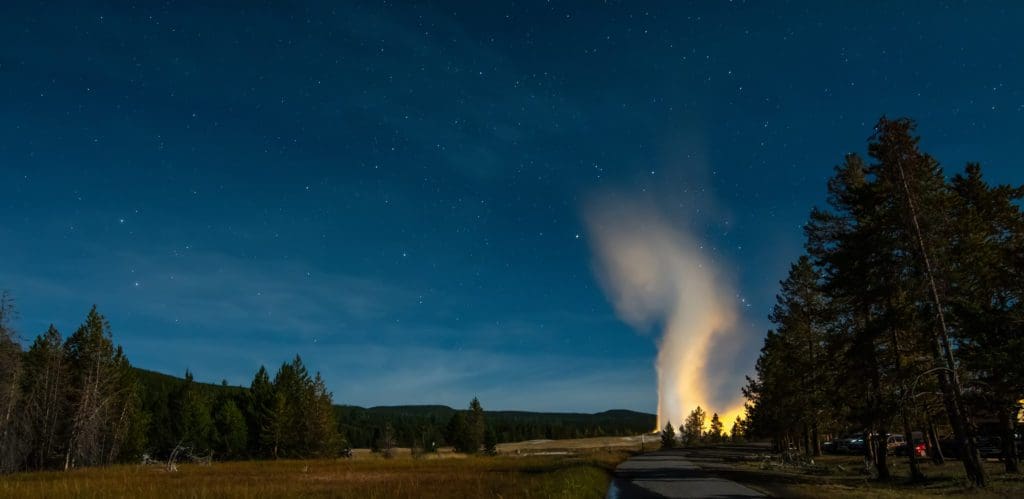
Eruption of Old Faithful geyser at Yellowstone National Park at night
That’s where we come in. We’ve compiled everything we know about Yellowstone and trimmed the fat to present you with the essential information you need to visit and enjoy the park. It contains some of the park’s colorful history, its natural splendor, and a thorough list of ways to explore and adventure while you’re there. Whether you’re planning a trip to the “land of fire and brimstone” or have never even thought about it, this guide was made with you in mind. If it works how we intended, it may be the start of your next adventure.
Table of Contents:
Article Navigation: Click on any of the listed items in the table of contents below to jump to that section of the article. Similarly, clicking on any large, white section header will jump you back to the Table of Contents.
- Overview
- The Story of Yellowstone
- Yellowstone Geology: The Earth in Motion
- The Greater Yellowstone Ecosystem
- Main Attractions
- America’s Best Idea
The Story of Yellowstone
As with most places in the United States, humans have been inhabiting the Yellowstone region for thousands of years. This is evidenced by over 1,000 archaeological sites found across the park. Based on what we can learn from the things they left behind, the Clovis People were Yellowstone’s first inhabitants. Almost every modern culture of Native peoples in the Americas traces its ancestry to the Clovis culture, including the 27 modern tribes that have some association with Yellowstone.

Falls in Grand Canyon of the Yellowstone National Park, Wyoming
This includes the Hidatsa People. The name “Yellowstone” is roughly translated from the Hidatsa “Yellow Rock River.” Their name for the river is thought to come from the yellow rock found in the Grand Canyon of The Yellowstone. Another prominent group to inhabit the park before its establishment are the Eastern Shoshone Sheepeaters. They were the only tribe to live in what is now Yellowstone year-round, and notably a very hardy group – persisting in rugged, mountainous terrain and hunting bighorn sheep as their primary food source.
The first white explorers to penetrate the Yellowstone Caldera were French beaver trappers. Mountain man John Colter would later traverse the broad plain on a trek south after detaching from the Louis and Clark Expedition. Colter called Yellowstone a place of “fire and brimstone,” observing (and probably also smelling) the geothermal pools and geysers of the park. Rumors of the park’s seemingly supernatural features spread as more mountain men trickled into the area over the next half-century.

Grand Prismatic Pool at Yellowstone National Park.
Looking For An Amazing Adventure? Book A Guided Hiking, Backpacking or Backcountry Skiing Tour in Yellowstone National Park
It would take several attempts to verify the myths of boiling springs, jets of steaming water, and mountains of yellow rock hidden somewhere in the Northern Rockies. In 1859 a contingent led by surveyor William F. Raynolds and guided by mountain man Jim Bridger pushed into the region, but were caught in a blizzard.
Also in this cast of characters was Ferdinand Hayden, a naturalist and geologist. After the Civil War, Hayden would try again to explore the Yellowstone region. He succeeded in 1871, completing the first federally-funded survey of the Yellowstone River drainage. The report he drafted based on this expedition is credited as having convinced the U.S. Congress to set the land aside for public use. The next year, President Grant would sign The Act of Dedication, setting aside Yellowstone as the world’s first National Park. This single stroke of the pen set a precedent which continues to this day; for the value of public land and the protection of unique, wild, and pristine natural landscapes.
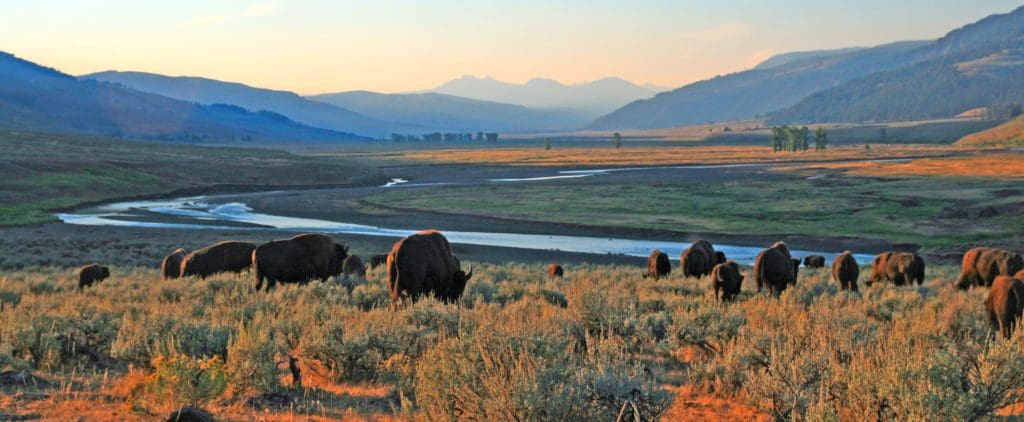
Bison Buffalo herd in early morning light in the Lamar Valley of Yellowstone National Park in Wyoiming USA
But the story of Yellowstone doesn’t end there. Far from it. The enactment of the Park as land which could not be bought and sold or harvested for financial gain was widely opposed, especially among locals. With the limitations of public land came new crimes; perpetrated against the land itself. The crime of poaching exploded, with recorded cases of nearly every type of animal that could be found in the park being killed illegally. The harvest of elk ivory would drive poaching to an extent that would hamper elk populations for decades to come. Luckily, the impacts of poaching on wildlife populations were largely curbed by the creation of the National Park Service in 1918.

Abyss Pool in the West Thumb Geyser Basin of Yellowstone National Park, Wyoming
Rippling effects of the Park’s creation changed life for everything, and everyone that lived there. Shortly after Yellowstone’s enactment, as many as half a dozen tribes of Native peoples were ousted. The Eastern Shoshone Sheepeaters received a particularly raw deal – their claim to existing in the park was summarily denied by the U.S. Government and they were extirpated entirely.
In many ways, the developing history of public land centers around Yellowstone to this day. Issues regarding fire management, the loss of biodiversity by “pest” species like wolves (and their subsequent reintroduction), habituation of predators such as bears, the spread of invasive species, and the impacts of recreation on protected land often center around Yellowstone National Park. The conclusions of these debates have far-reaching consequences, continuing the pattern of precedents for the world being set in Yellowstone National Park.
Yellowstone Geology: The Earth in Motion
Yellowstone National Park is grand for a lot of reasons. But its geological history is what makes it unique. Yellowstone features pots of boiling mud, over half of the world’s geysers (including Steamboat Geyser, the largest on earth), cliffs made of obsidian, and more fantastic hotsprings than you can shake a stick at.
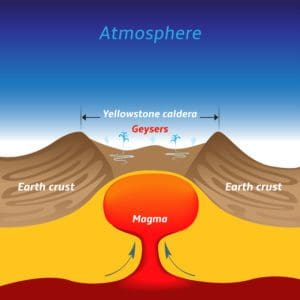
Yellowstone caldera
Nearly all of these marvels are generated by volcanism. Specifically, Yellowstone National Park sits atop the Yellowstone Caldera, one of the largest supervolcanoes on earth. If it exploded, as active volcanoes are want to do, the effects would be catastrophic. However, it’s highly unlikely that we will live to see anything like that happen. While the caldera is highly active, geologists predict another major eruption won’t happen for thousands of years.
Instead, we have the opportunity to witness the marvels that come with having a colossal bed of magma just under our feet. Marvels like Grand Prismatic Spring, the third largest hot spring on earth, which is colored by microbial extremophiles – bacteria which can survive at unimaginable temperatures. Or like Old Faithful, the most famous geyser on earth. Others like the aforementioned mudpots and terraces of travertine like those seen at Mammoth Hot Springs take very specific conditions and lots of time to form. Of course, there are no wrong answers to how you spend your time in Yellowstone National Park, but these geothermal features are masterpieces of natural art worthy of any bucket list.
And as if that wasn’t enough, Yellowstone also showcases the magic of weathering and erosion as well. The Grand Canyon of The Yellowstone is a spectacle of the raw power that water holds over the landscape. And even more interestingly, Yellowstone sits directly on the Continental Divide. This means that following rivers in the north of the park, you would end up 1,200 miles away in the Gulf of Mexico, whereas following rivers in the south would land you in the Pacific Ocean.
The Greater Yellowstone Ecosystem
The life history of Yellowstone is so complex and well-documented that it has its own name: The Greater Yellowstone Ecosystem. This area covers the bulk of the park itself and stretches south over the John D. Rockefeller Parkway and Grand Teton National Park. But what sets it apart? Well, all the things you picture when you think of Yellowstone, really. Mountainous stretches looming over low valleys of sagebrush teeming with springs, brooks, and rivers. Dense stands of lodgepole pine rolling up the sides of jagged granite peaks, into higher mountain valleys where Douglas firs and quaking aspens flourish. Wide swaths of willow flats full of moose, bears, and beaver.
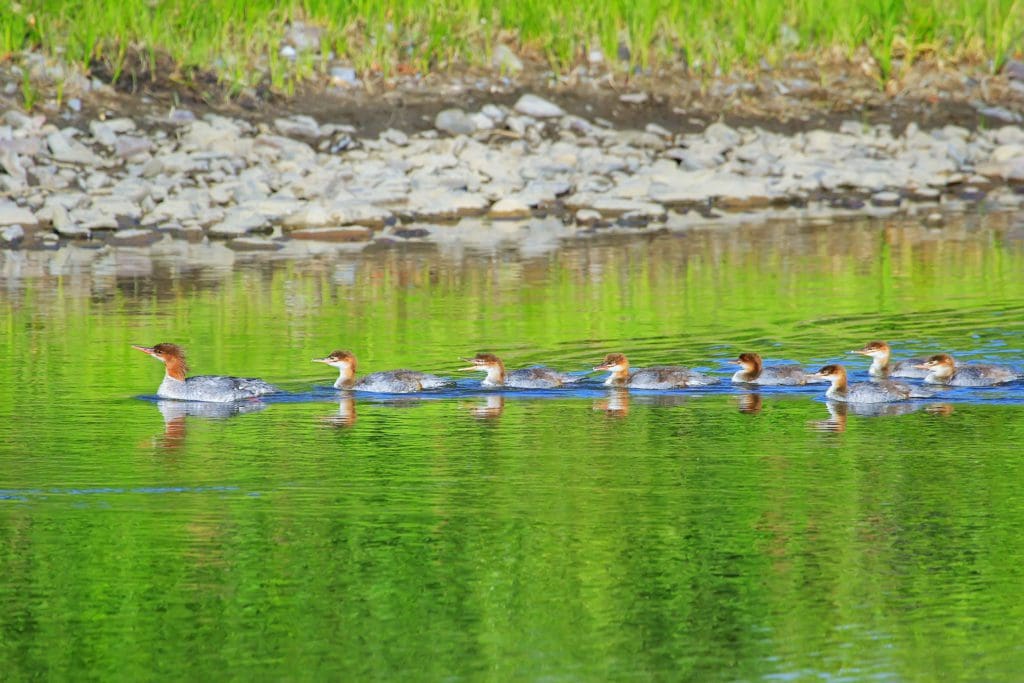
Female red-breasted merganser (Mergus serrator) with ducklings in Yellowstone National Park, Wyoming.
Even moreso, the Greater Yellowstone Ecosystem is notable because of the vast diversity of wildlife species that inhabit it. Anyone with a trained eye will be floored by the variety of animals that can be found here. For starters, it’s a stomping ground for throngs of birds, both seasonal visitors and year-rounders. From ospreys to dippers to elusive harlequin ducks, the birds of Yellowstone run the full gamut of colors, shapes, and ecological niches.
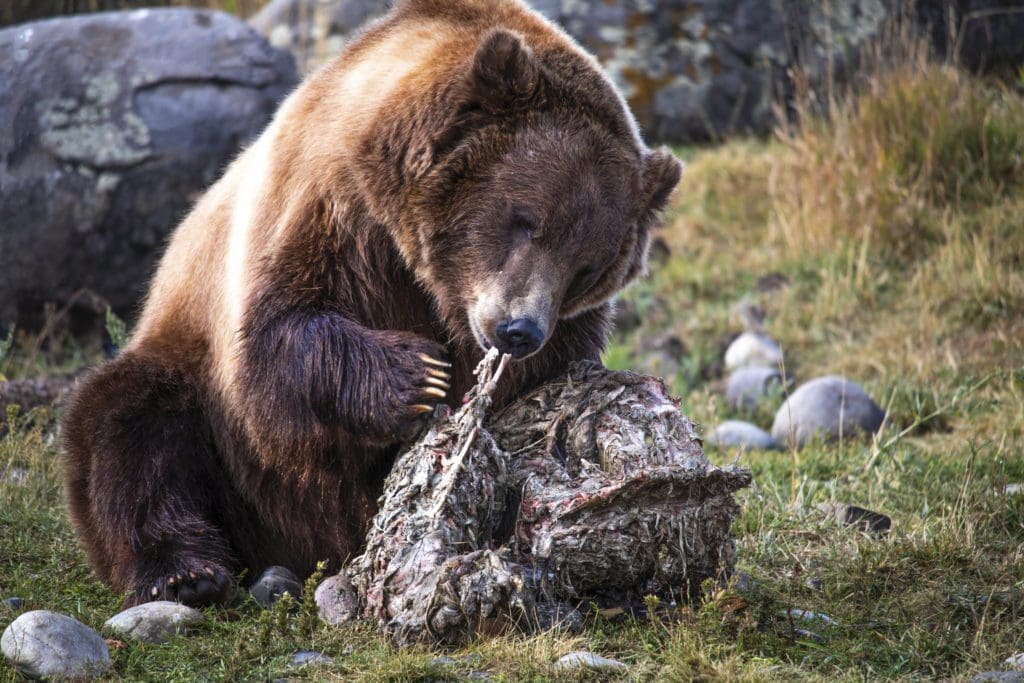
Grizzly Bear Eating Elk Carcass in Yellowstone National Park.
But what most folks come to Yellowstone to see are magnificent multitudes of mammals. Plain and simple, seeing the sheer enormity of a herd of hundreds bison ambling over the steppes is unmatched. And that’s the tip of the iceberg. Yellowstone holds the largest ecologically intact community of mammals in the continental US. In total there are 67 species of mammals in the park. Grizzly and black bears, pronghorn, tremendous herds of elk, towering moose, wolverines, and of course, wolves are all here in large abundance (and this is just naming a few of the park’s awe-inspiring mammals). This network of species thrives through harsh winters, migrating when necessary to follow sources of food over the landscape.
It’s not the kind of thing you’ll be able to see in a day. But after a weekend or so you begin to get a sense that each living thing you see in Yellowstone is connected to the rest. If a wolf eats a beaver, and that beaver’s dam collapses, it can change the shape of a river. If a wildfire consumes thousands of acres, the forest must start over. And it will. These are all dramatic movements in Yellowstone’s natural history that we can observe before our very eyes.
Main Attractions
What exactly the biggest attraction in Yellowstone is depends completely on who you ask. The geysers, the wildlife, the peaks and canyons, rivers and lakes are all outstanding and worth your time. But say you just had a weekend in Yellowstone, what would your short list look like?

Yellowstone National Park sign
Well for one, you’d need to see some of the postcard-picture-perfect geysers in the park. Old Faithful, the most famous geyser on earth, definitely lives up to the hype. It can be found at the end of the Upper Geyser Basin, which is jam packed with geothermal wonders. Norris Geyser Basin is also well worth the time you’ll spend wandering through the many geysers and pools that can be found there. Grand Prismatic Spring, found in the Midway Geyser Basin, sits on a short loop trail which also passes Opal Pool, Turquoise Pool, and Excelsior geyser. All of these features are relatively close together, running along the western side of the main loop of the Park.

Midway Geyser Basin in Yellowstone.
The more you venture out from the loop of roads that loosely follows the Yellowstone Caldera, the more unique features you’ll see. Further North, you can find Mammoth Hot Spring and Sheepeater Cliff, the aforementioned wall of obsidian and columnar basalt (à la Giant’s Causeway in Ireland). If wildlife watching is your main goal, head east. Lamar Valley and Hayden Valley are the must-see spots for catching a glimpse of the park’s enigmatic animals. As a detour, there are also mud pots which are easily accessible from the road in Hayden Valley, as well as the northern edge of Yellowstone Lake.
The key to doing Yellowstone right is singling out what interests you the most and spending some time just enjoying the land. Geysers spout, bears and moose rear their heads, but they do so on their own clocks. These things take time, and if you’re patient (and observant), you’ll see it all. Take a load off, walk slowly, and drive with ease. Nature bends to no man’s schedule.
Wildlife Watching
For wildlife enthusiasts, Yellowstone is a world-class opportunity to get “up close” and personal with charismatic mammals in high abundance, without all the fuss of heading all the way to Alaska and hiring a bush plane. In Yellowstone, just cruising along the park roads, you can easily expect to see elk, moose, black and grizzly bears, and wolves. But that doesn’t even begin to skim the surface of the wild animals that you could see on a given day in Yellowstone. The park’s mammals are the main event: river otters, bobcats, cougars, coyotes, foxes, porcupines, even wolverines can be found across Yellowstone. One approach to seeing lots of wildlife in the park is trolling the major roads, although this does take a fair amount of luck.
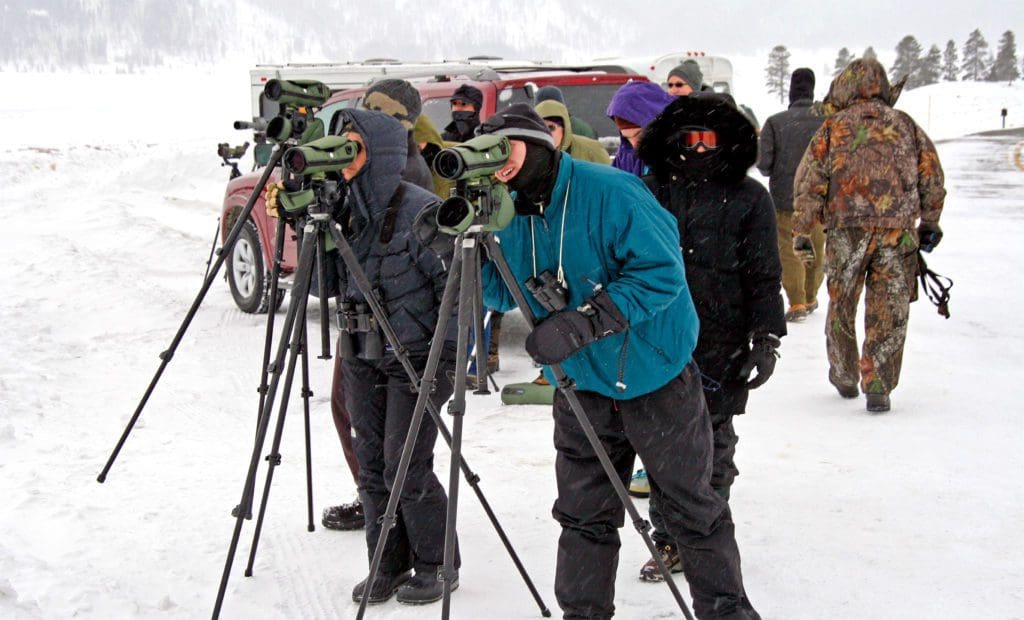
Wild Grey Wolf in Yellowstone National park, Wyoming.
Gear Review: Jackery 1500 Generator and Yellowstone’s Wolf Watchers. A student film crew takes the Jackery 1500 Solar Generator to Yellowstone on a photo shoot to document the wolf watching community and to contextualize the community against changes and tensions occurring in and around the park.

Black Wolf Catches a Scent of another animal in Yellowstone’s Lamar Valley.
If you want to maximize your odds of seeing the park’s photogenic inhabitants, there are a few wildlife hotspots across Yellowstone where you’re almost guaranteed to see something rare. Standouts are Hayden Valley (for bison, elk, bears, and wolves) and Lamar Valley (everything in Hayden Valley plus pronghorn and bighorn sheep). Lamar Valley is home to the Lamar Valley Pack, one of the most famous wolf packs in the world. Wildlife enthusiasts return to Yellowstone every year to track the movements and daily dramas of the Lamar Valley Pack’s members. If you have a love of things that are wild and untamed in you, seeing wolves stalk through breaks of willow on the banks of the Lamar River or howl at the moon is something you can’t miss.

A Male Mountain Bluebird perching on a low tree, Yellowstone National Park.
But that’s hardly the entire spectacle of wildlife watching in Yellowstone. Lovers of birds, amphibians, and fish can all find fantastic specimens in their element here. Be sure to bring your binoculars and camera. But most of all, be patient, and be courteous to wildlife. Bison and bear jams can stop traffic on roads, but don’t fret. This is what you came for, after all. And when viewing wildlife outside of your vehicle, maintain your distance. The park requires you to keep 25 yards of space for viewing most kinds of wildlife, and 100 yards for predators (like wolves and bears). Remember that wildlife are first and foremost wild, and therefore dangerous. It is your responsibility as a visitor to ensure that wildlife do not hurt you. “Problem animals” are almost always euthanized, and generally for nothing more than a mistake made by a person who got too close or left food unattended.
Best Day Hikes
There are countless miles of trails in Yellowstone which lead across, over, and through some of the most unique sights on earth. What you should do depends on what you like – there are short trails with huge payoffs, long, flat traverses through pine forests, and ascents to mountain summits across Yellowstone. If you’re up for a leisurely, mostly flat jaunt with the potential for wildlife sightings, Lamar River to Cache Creek is perfect. Fairy Falls to Imperial and Spray Geysers Trail is a no-filler approach to seeing the sights of the Midway Geyser Basin, including the best view of Grand Prismatic Spring you can get.
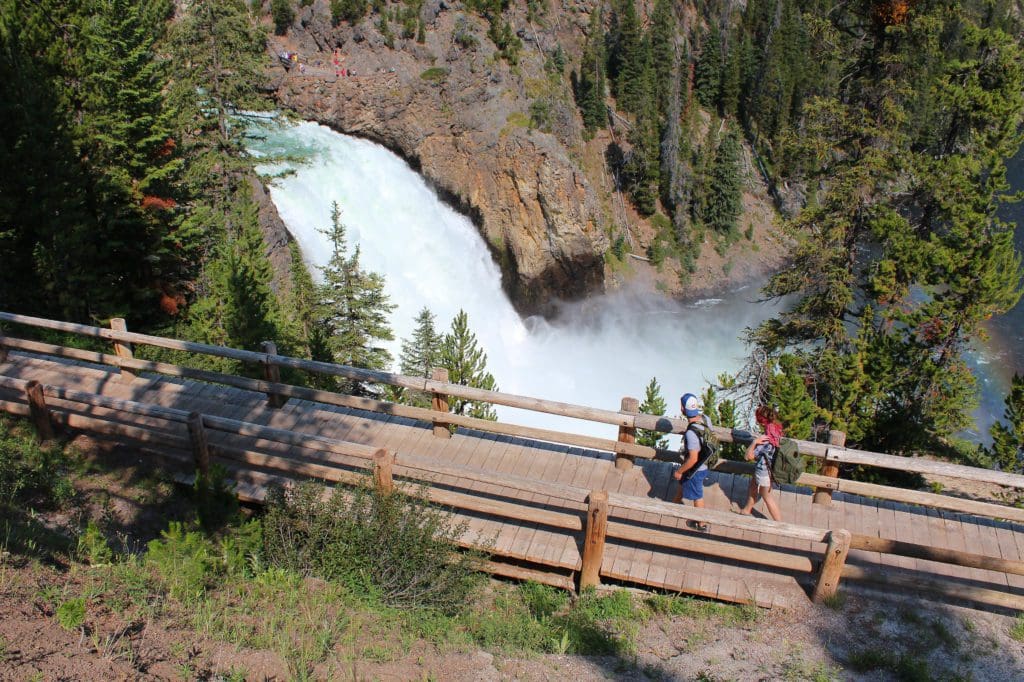
Hikers near the Grand Canyon of the Yellowstone’s Upper Falls
For something a little more athletic, Dunraven Pass to Mount Washburn covers 7 miles over almost 1,400 feet of elevation through mountains, meadows, and pine forests. It’s a feast of mountain landscapes, wildflowers, and includes a 10,000+ foot summit. But if bagging a few peaks is what you came for, you’ll probably be more interested in Electric Peak or Bunsen Peak. Electric Peak is a more sporty, strenuous ascent over 5700 feet and 20-ish miles to the top of the aptly-named peak. Bunsen Peak is much more mellow, but includes views of large cliffs and sweeping panoramas.
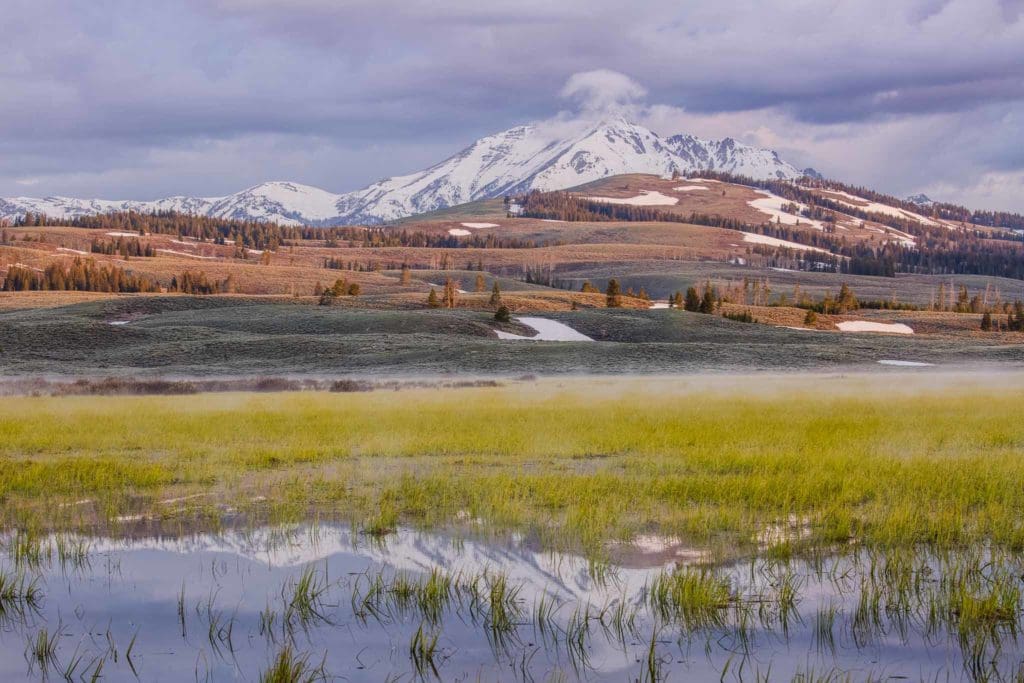
Fog over marsh below Electric Peak and Gallatin Range.
Lastly, if you’re a fan of waterfalls you wouldn’t want to miss the Bring of The Lower Falls Trail. It’s a mile in total and leads to the North Rim of the Grand Canyon of The Yellowstone, and Lower Falls. This waterfall is over 300 feet high, and the canyon around it shows off the yellow rock for which the park is named. If you’ve got even an hour to spare, don’t miss it.
You can find more info on each of these trails here.
Camping
Yellowstone National Park is one of the more remote corners of The West, and as such some of the best accommodations you’ll find are right here. Curling up next to a nice warm campfire under all the stars in the sky is one of the best ways to unwind from a day of sightseeing and adventuring. There are lots and lots of places you can camp in Yellowstone, but be aware that during the busy season campgrounds do fill up. As a rule of thumb, always try to plan your trip as far in advance as possible so you can get a campsite.

Man sitting next to campfire and tent in Yellowstone National Park.
But suppose you do plan far enough out, how do you choose where to go? For starters, think about what you want to spend your time doing. Madison Campground is maybe the best location-wise, especially if you’re going to spend a lot of time hiking around geysers and hot pots. Norris and Canyon Campgrounds are also prime real estate for sightseeing. If you’re keen on wildlife watching, Pebble Creek and Tower Fall are near Lamar Valley. Mammoth Campground is also a top choice, situated right next to Mammoth Hot Spring. Campgrounds range from $20-32 per night and most have standard amenities that you could expect at a primitive campground. The more centrally located spots like Canyon and Madison also have stores with general goods, dump stations, laundry, ice, and firewood.
As always, just remember to be bear aware while camping in the park and pack your food and scented items away properly. Bears have become habituated to human interaction over the last century and have been known to destroy tents and cars to get to smelly items.
Backpacking
The trackless wilderness of Yellowstone is ideal for long-distance hiking and backpacking. There are corners of the park scarcely seen by visitors because of their remoteness, but all it takes to venture out is the gear and the gumption to go the distance. As far as logistics goes, there are some good resources on the park’s website to get you going. You’ll need to plot your trip along established trails and plan your nights in designated backcountry campsites. More importantly, you’ll need to have a plan for food storage and potential wildlife encounters. You can rent an approved bear canister from the park, or bring your own as long as it meets park requirements. Bear spray is also highly recommended at all times. Lastly, be sure to follow fire restrictions while backpacking in the park at all times. During fire season, one stray ember is all it would take to completely raze the entire park.
The options for building a trip can be overwhelming. There are literally hundreds of combinations of trails and campsites you can visit, covering everything from overnighters to whole weeks in the backcountry. If you don’t know where to start, we put together a short list of popular options for you. All are rated moderate and fall in the 30-40 mile range, making for anywhere from two to five days of backpacking depending on your fitness and preferred pace.
First is Bechler River Trail, a forested trek through the southwestern corner of the park. Access to water is good, and you’ll encounter some waterfalls and natural hot springs along the way. Next is Heart Lake Loop, a beautiful circuit of an alpine lake which drops down from the highway at first and remains mostly flat until you make your way back. Last, check out the Lamar River Trail. This is a romp into the fabled Lamar Valley, with tons of wildlife to be seen along the way. There’s a lot of up and down as you slowly gain elevation before returning the way you came.
Fishing
With all of the incredible waterways in Yellowstone it goes without saying that the park holds some of the best trout fishing in the country. There are beautiful native species like the Westslope and Yellowstone Cutthroat Trout, Arctic Grayling, and Mountain Whitefish, which populate Yellowstone’s lakes and rivers. The local cutthroat are especially sought-after among hardcore trout anglers.
On top of this, there are plenty of playful nonnative species, which you can keep upon catching. Brown trout, rainbow trout, and brook trout are commonly found in the park’s rivers and best caught on the fly. And in Yellowstone Lake you’ll find huge Lake Trout – which must be killed upon capture (more for you!). These monsters can reach 48” long and 50 lbs. If you plan on bringing your boat to the park, be sure to pack some heavy duty fishing line.

Fly Fishing in Yellowstone.
Rafting and Boating
Whether your tastes lie more on the side of still water or whitewater, Yellowstone has got you covered. You can raft sections of the Yellowstone, Madison, and Gallatin Rivers, all of which are rewarding adventures through beautiful scenery. You might prefer to link up with a raft guide like Yellowstone Raft Company, to take care of the particulars (and get you through the rapids alive). If motorized watercraft are more your speed, you can put in on Yellowstone Lake and explore to your heart’s content. Just be sure to follow park guidelines on preventing the spread of aquatic invasive species.
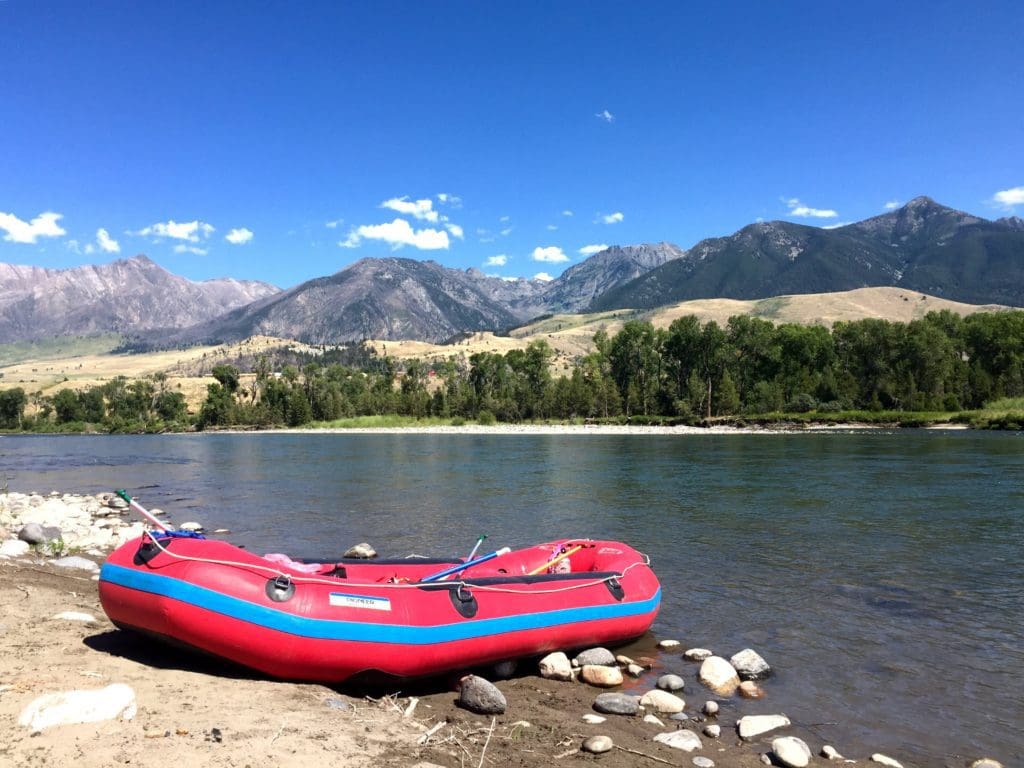
Red Inflatable Raft Moored On the Yellowstone River.
Horseback Riding
Exploring the Yellowstone sidecountry on horseback is an incredible experience. You can either charter a private guide to take you through the park, or bring your own stock animals with you. Chartering a guide takes care of the organizational headache and preparation involved in taking a trip with your animals into the park. If you want to bring your own stock, there are a few things you need to make sure of. Each animal has to have a recent negative Coggins Test to enter the park. You must also follow park rules on stock packing. And remember while riding to be conscientious of spreading invasive weeds.

Horesback Riders in Yellowstone National Park
Cycling
Yellowstone is a dream for both mountain bikers and road cyclists. There are mountain biking trails all over the park, including the Lone Star Geyser Basin and Mammoth Hot Springs areas. Some of the standouts are Bunsen Peak Trail and the Old Gardiner Road. Don’t expect to have your technical abilities challenged too much. Cycling in Yellowstone is more about taking it easy and enjoying the incredible scenery.
If you prefer to stick to the roads, there are plenty of routes through and around the park. One popular option for long-distance bike touring is to start in Gardiner, Montana and cross the entire park north to south. Once you reach the southern entrance, you can cross the John D. Rockefeller Parkway into Grand Teton National Park and continue all the way to Jackson Hole, Wyoming. This trip totals 152 miles of pure natural grandeur over well-maintained roadways. If you’d prefer a loop, you could ride along the central ring of roads in the park. This trip passes through all of the major park highlights including the Upper and Midway Geyser Basins and the West Thumb of Yellowstone Lake. It totals 93 miles. Either way the options for camping are abundant, the views are fantastic, and you’ll be set for the bike tour of a lifetime.
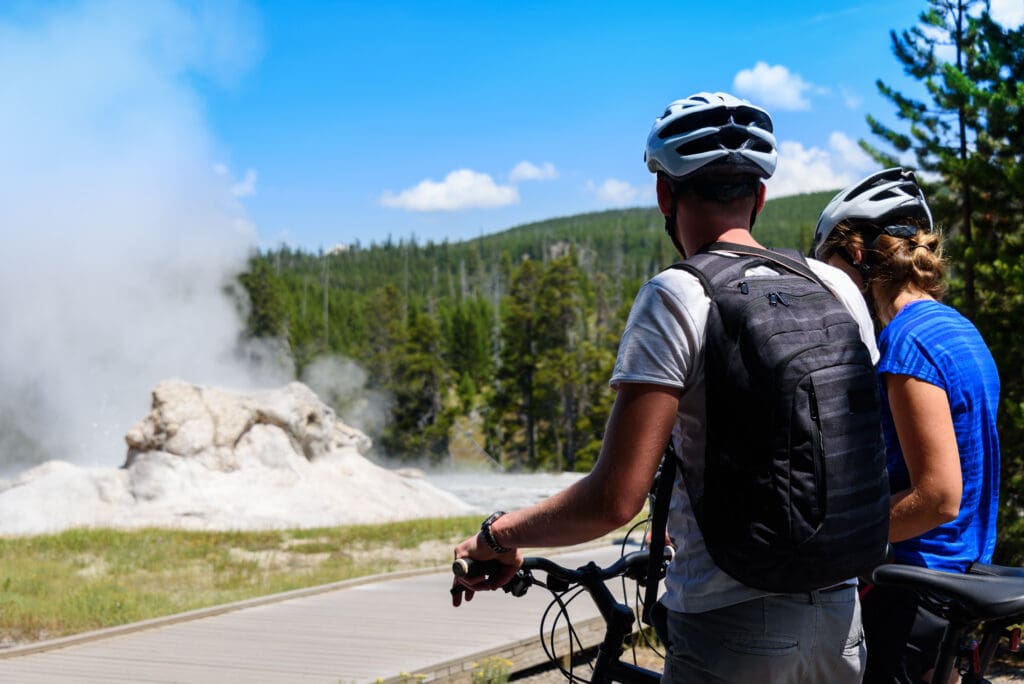
Bicyclists watching a geyser in Yellowstone National Park
America’s Best Idea
Everything you can see, touch, and photograph in Yellowstone National Park is part of a bigger picture. It’s a living story told in the movement of its pieces. The elk that push through driving snows to find food come winter, the geothermal piping that keeps Old Faithful running like clockwork, the seasons that come and go, the packs of wolves that grow and recede with the elk are all threads in a tapestry. If you perch yourself on a given ridge, with a decent pair of binoculars, you can watch the movement of Yellowstone. It breathes, and grows, and changes. And if you watch long enough, you might start to notice that the land is alive. That’s the magic of Yellowstone. It’s why the idea of preserving natural beauty for future generations has been called “America’s best idea.”
Don’t believe us? Well then you had better come and see for yourself.
Skyblue Overland Strongly Recommends That You Enroll With Global Rescue Prior To Embarking On Your Next Adventure.
Purchase a Global Rescue membership for your next adventure and travel with peace of mind. Single trip, annual and family options are available.
Learn More!
POPULAR ARTICLES:
Top Adventure Sports Towns 2021: Jackson, Wyoming
Gear Review: Jackery 1500 Solar Generator and Yellowstone’s Wolf Watchers
Women Who Shred: Backcountry Skiing in the Tetons
The Adventurer’s Guide to Grand Teton National Park, Wyoming
The Dyrt: The Best Camping Near Grand Teton National Park
New Glamping Resort Opens on the Yellowstone River in Paradise Valley, Montana
Terms of Use: As with each guide published on SKYBLUEOVERLAND.com, should you choose to this route, do so at your own risk. Prior to setting out check current local weather, conditions, and land/road closures. While taking a trail, obey all public and private land use restrictions and rules, carry proper safety and navigational equipment, and of course, follow the #leavenotrace guidelines. The information found herein is simply a planning resource to be used as a point of inspiration in conjunction with your own due-diligence. In spite of the fact that this route, associated GPS track (GPX and maps), and all route guidelines were prepared under diligent research by the specified contributor and/or contributors, the accuracy of such and judgement of the author is not guaranteed. SKYBLUE OVERLAND LLC, its partners, associates, and contributors are in no way liable for personal injury, damage to personal property, or any other such situation that might happen to individuals following this route.











